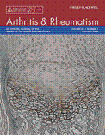Stimulation of nicotinic acetylcholine receptors attenuates collagen-induced arthritis in mice
Abstract
Objective
The parasympathetic nervous system, through the vagus nerve, can down-regulate inflammation in vivo by decreasing the release of cytokines, including tumor necrosis factor α (TNFα), by activated macrophages. The vagus nerve may exert antiinflammatory actions via a specific effect of its principal neurotransmitter, acetylcholine, on the α7 subunit of nicotinic acetylcholine receptors (α7nAChR) on macrophages. The present study was undertaken to obtain insight into the role of the cholinergic antiinflammatory pathway in arthritis.
Methods
To inhibit the cholinergic antiinflammatory pathway, mice were subjected to unilateral cervical vagotomy or sham surgery, after which arthritis was induced with type II collagen. In a separate study, nicotine was added to the drinking water of mice with collagen-induced arthritis (CIA). In addition, we investigated the effects of intraperitoneally (IP)–injected nicotine and the specific α7nAChR agonist AR-R17779.
Results
Clinical arthritis was exacerbated by vagotomy and ameliorated by oral nicotine administration. Moreover, oral nicotine inhibited bone degradation and reduced TNFα expression in synovial tissue. Both IP-injected nicotine and AR-R17779 ameliorated clinical arthritis and reduced synovial inflammation. This was accompanied by a reduction of TNFα levels in both plasma and synovial tissue. The effect of AR-R17779 was more potent compared with that of nicotine and was associated with delayed onset of the disease as well as with protection against joint destruction.
Conclusion
These data provide the first evidence of a role of the cholinergic antiinflammatory pathway in the murine CIA model of rheumatoid arthritis.




